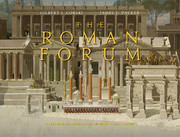Book contents
- Frontmatter
- Map
- Contents
- Preface
- Acknowledgments
- Part I. Architecture in the Roman Forum during the Empire: A Brief History
- Part II. The Monuments
- 3 The Temple of Antoninus and Faustina
- 4 The Temple of Caesar (Aedes divi Iuli)
- 5 The Basilica Æmilia
- 6 The Curia
- 7 The Arch of Septimius Severus
- 8 Minor Monuments
- 9 The Temple of Concord
- 10 The Temple of Vespasian
- 11 The Tabularium
- 12 The Portico of the Dei Consentes
- 13 The Temple of Saturn
- 14 The Basilica Julia
- 15 The Arch of Tiberius
- 16 The Schola Xanthi
- 17 The Diocletianic Honorary Columns
- 18 The Temple of Castor and Pollux
- 19 The Parthian Arch of Augustus (19 BCE)
- 20 The Temple of Vesta
- Part III. Conclusions
- Glossary
- Notes
- Bibliography
- Sources for Coin Images from the Internet and for Other Images
- Index
4 - The Temple of Caesar (Aedes divi Iuli)
from Part II. - The Monuments
Published online by Cambridge University Press: 05 March 2015
- Frontmatter
- Map
- Contents
- Preface
- Acknowledgments
- Part I. Architecture in the Roman Forum during the Empire: A Brief History
- Part II. The Monuments
- 3 The Temple of Antoninus and Faustina
- 4 The Temple of Caesar (Aedes divi Iuli)
- 5 The Basilica Æmilia
- 6 The Curia
- 7 The Arch of Septimius Severus
- 8 Minor Monuments
- 9 The Temple of Concord
- 10 The Temple of Vespasian
- 11 The Tabularium
- 12 The Portico of the Dei Consentes
- 13 The Temple of Saturn
- 14 The Basilica Julia
- 15 The Arch of Tiberius
- 16 The Schola Xanthi
- 17 The Diocletianic Honorary Columns
- 18 The Temple of Castor and Pollux
- 19 The Parthian Arch of Augustus (19 BCE)
- 20 The Temple of Vesta
- Part III. Conclusions
- Glossary
- Notes
- Bibliography
- Sources for Coin Images from the Internet and for Other Images
- Index
Summary
History
The momentous events that followed Caesar’s assassination (March 15, 44 BCE) inspired the construction of a temple dedicated to his divine spirit. As Pontifex Maximus, high priest of the Roman state, Caesar formally lived in the Regia, the official residence of the Pontifex Maximus. The slain dictator’s body was carried back to the Forum, and Mark Antony – then consul, Caesar’s friend, relative, and lieutenant – delivered a brilliant funeral oration. Standing on the Rostra in front of the Temple of Castor and Pollux, he called Caesar superhuman, inviolable, and a veritable god and lifted the dictator’s bloody robe on a spear. While the audience echoed his lamentations, he chanted the dictator’s honors and achievements, and, when an aide raised on high a life-sized wax image of Caesar clearly showing his many brutal wounds, the crowd rioted. Led (says Suetonius) by two divine spirits with swords, the spectators set fire to the bier, feeding the flames with nearby wooden benches. Soldiers threw in their weapons, and women, their jewels and amulets of their children. The frantic grief of the wild scene spread throughout the city as groups of foreigners ran through the streets bewailing Caesar’s death. To honor Caesar’s memory on the site of his funeral pyre, in front of the Regia about halfway between the front of the Basilica Aemilia and the Temple of Castor, the people set up an altar with a giallo antico column almost twenty Roman feet high (5.92 m) with the inscription PARENTI PATRIAE (to the father of his country).
- Type
- Chapter
- Information
- The Roman ForumA Reconstruction and Architectural Guide, pp. 82 - 90Publisher: Cambridge University PressPrint publication year: 2015



